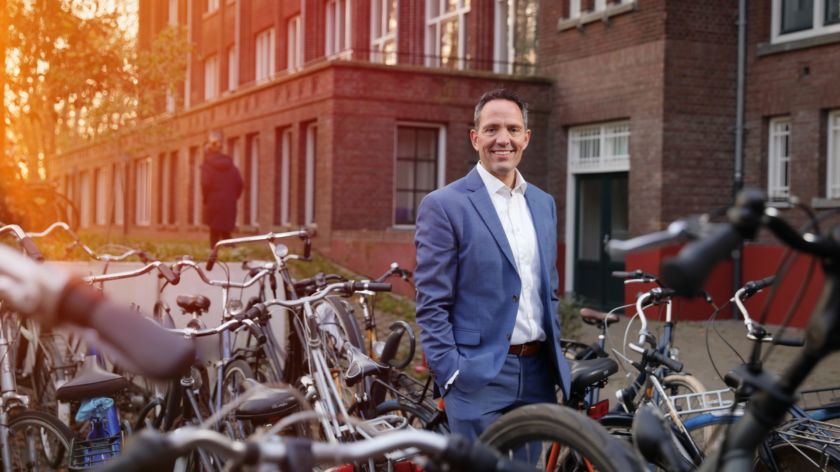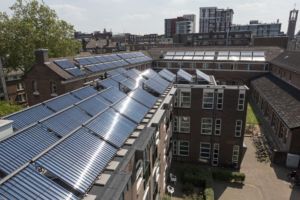On the road to a CO2-neutral SSH&: ‘I don’t believe in one single solution’
-
 Kees Stunnenberg. Foto: Eric Scholten
Kees Stunnenberg. Foto: Eric Scholten
Student housing provider SSH& has (almost) as many solar panels as tenants. The goal is to have all building be CO2 neutral by 2045 – without the use of natural gas. How? According to director Kees Stunnenberg there is no default solution. ‘That is what makes it so complicated.’
Next year, SSH& complex Sterrenbosch will be connected to the sustainable heating system of Radboud University, the aquifer thermal energy storage (ATES). ‘It would be stupid not to take advantage of this opportunity’, said SSH& director Kees Stunnenberg. After all, it fits SSH&’s ambition to be completely CO2 neutral by 2045.
How do you look at other complexes in the neighbourhood? Can those also be connected to the university’s heating network?
‘The hospital has its own ATES, which is separate from the heating network of the university. This year we will be connecting Nestor (the old nurses apartment building next to the study centre of Radboudumc, ed.) to this. The building is ready, just like Sterrenbosch. It’s low-hanging fruit.’
And the complexes just outside the campus, like Hoogeveldt and the Gouverneur?
‘There is a train track in-between. That makes it difficult to make the connection with the campus. It is possible that city heating will be installed there in the future, and if not, we will need to look for different solutions for those complexes.’
‘We first look at the affordability for the tenants’
In 2020 you completed Tilde, the renewed complex at the Van Nispenstraat, without a gas connection. How did you do that?
‘With Tilde, we went for an all-electric solution (with a combination of solar panels and heat pumps, ed.). That is one of the alternative solutions for gas, but a really expensive one at that. You need a large roof area to cover with solar panels. However, you can not save the energy that you generate, because there are no good batteries on the market yet. Therefore, you’ll feed a lot back to the grid. At night, when it’s dark outside, tenants use a lot of power, but you generate nothing. It is possible that this alternative to gas will become more interesting in the future because panels are becoming more efficient and heat pumps more economical’.
So what is your strategy on the road to 2045?
‘We are aligning ourselves as much as possible with the municipality’s vision on heating. If a neighbourhood is connected to the heat network (city heating, ed.) we naturally want to make use of it. We have a road map that lists all the complexes. Every time a complex is due for major maintenance, for example, we look for the best solution. Are we going to wait for the municipality, or are we going to do things differently? Are there any new innovations?’
‘At Doddendaal, for example, we reduced gas consumption with a solar thermal system (see photo, ed.). We have panels on the roof that have water flowing through them. The heated water is stored in a container under the Doddendaal tower – a kind of water battery. At Mariënbosch, we burn biomass. Only at peak times, we do still need gas.’
There is no standard solution that applies to all your buildings.
‘No, that’s what makes it so complicated. I don’t believe in one single solution. Electricity is not the solution for all complexes, but neither is heat from the ground. We have to weigh up the possibilities for each complex.’
What is the decisive factor?
‘No matter how important sustainability is, as a student housing provider we always first look at the affordability for the tenant. What are they prepared to pay? The cost of living for students is already high. More than ever, energy plays a role in this. We invest in sustainability to keep rents affordable. We started installing solar panels in 2005. Now we have over 7200 of them. With almost 7400 tenants, almost every student has his or her own solar panel.’
Which complexes do you want to tackle in the short term, besides Sterrenbosch and Nestor?
‘We just finished with Heidepark (west of the Goffertpark, ed.) – we have not yet removed the gas from that complex, but we have prepared it for city heating. Now we’re looking at Thijmstraat in the Willemskwartier. Are we going to wait for the municipality there too, as we did for Heidepark, or are we going to work with heat pumps? We also always look at the surroundings: are there perhaps companies or houses in the neighbourhood that want to build a heat plot together, as is now happening for example in Hengstdal?’
‘The same applies to new buildings. At the current location of the Municipal Health Service on the Groenewoudseweg (which is to be demolished and where SSH& wants to build a complex, ed.) we might be able to do something together with the ROC. Supplying new buildings with a gas heating system is no longer an option.’




